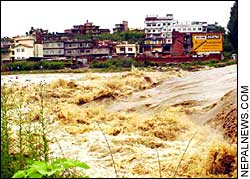 Floods and landslides are common in the Himalaya. What was unusual this time was the lack of information, the degree of unpreparedness, and the inadequacy of relief response.
Floods and landslides are common in the Himalaya. What was unusual this time was the lack of information, the degree of unpreparedness, and the inadequacy of relief response. It took three days for Kathmandu to be alerted to reports of the devastation in adjoining Makwanpur district where more than 100 people were washed away by floods. By Thursday afternoon, the official death toll had crossed 150, including 30 dead or missing in the valley. The figure does not include dozens who died of snake bites, most after being rushed to district hospitals which didn't have venom antidotes.

"I've seen worse rains and floods but not as many deaths," says environmentalist and broadcaster Bhairab Risal.
There are up to five cloudburst events in the Nepal Himalaya every monsoon season. These relentless and locally concentrated rain (like the 177 mm in 24 hours that fell in Kathmandu Valley on Monday night) cause massive flashfloods, landslides and river blockages. Given how common cloudburst events are, you would expect the government machinery to be geared up for it.
An expert group did recommended in 1996 that the government acquire one C-130 aircraft, eight helicopters, 157 trucks and vehicles, tents, communication equipment, 10 Bailey Bridges and rafts for emergency rescue. That report, like many others, gathers dust in government shelves. Neither the hazard maps nor the specialised rescue teams recommended in 1996 were set up.
This negligence was made worse this time because the government's information network is in a shambles. Maoists have destroyed phone lines in one-third of all districts, the local bodies which used to rush information and coordinate relief cease to exist, and the army and police are pre-occupied with fighting Maoists.
"This was a medium scale flood, something you would expect every 20 years or so," says water expert Dipak Gyawali, "the higher casualty figures are a result of encroachment of flood plains and urbanisation. The really worry is: what if we get a once-in-500-years type flood next time round." The government has a Central Disaster Relief Committee (CRDC) and recently set up a curiously named Department of Narcotics Control and Disaster Management at the Home Ministry to coordinate relief. The group met on Tuesday to take stock of damage, but relief is hampered by a lack of information on the ground situation. "Mitigation and prevention activities work best at the local level and these activities have to be decentralised," says UNDP's Man Bahadur Thapa. But the government seems to be more interested in the political advantages of relief after disasters strike. The UN itself has not set a good example: one of the areas inundated this week was the "UN Park" on the Bagmati floodplain in Thapthali. Garbage landfills and new roads along the Bagmati constricted flow, backing up flood waters.


